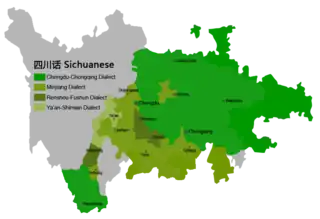| Minjiang | |
|---|---|
| Nanlu | |
| 岷江话 | |
| Pronunciation | [min˨˩tɕiaŋ˥xa˨˨˦] |
| Native to | China |
| Region | Sichuan, Chongqing, Guizhou and Yunnan |
Sino-Tibetan
| |
Early forms | Proto-Sino-Tibetan
|
| Dialects | Leshan |
| Language codes | |
| ISO 639-3 | – |
cmn-xgm | |
| Glottolog | None |
 | |
The Minjiang dialect (simplified Chinese: 岷江话; traditional Chinese: 岷江話, local pronunciation: [min˨˩tɕiaŋ˥xa˨˨˦]; pinyin: Mínjiānghuà) is a branch of Sichuanese, spoken mainly in the Min River (Mínjiāng) valley or along the Yangtze in the southern and western parts of the Sichuan Basin in China. There is also a language island of the Minjiang dialect located in the center of the Sichuan Basin covering several counties, including all of Xichong, Yanting, and Shehong Counties, and part of Jiange, Cangxi, Nanbu, Langzhong and Bazhong. The Minjiang dialect is also referred to as the Nanlu dialect by some scholars.
The primary characteristic of the Minjiang dialect is that the stop consonants for checked-tone syllables in Middle Chinese have developed into tense vowels to create a phonemic contrast, and in several cities and counties the tense vowels retain a following glottal stop. It also keeps many characteristics of Ba–Shu Chinese phonology and vocabulary.[1][2] Due to these characteristics, the status of the Minjiang dialect is disputed among linguists, with some classifying it as Southwestern Mandarin,[3] and others setting it apart as a continuation of Ba–Shu Chinese, the native language of Sichuan before the end of the Yuan dynasty.[4]
Notes
References
- ↑ Lan, Yong 蓝勇 (1997). 第十三章:历史时期西南综合文化区的划分 [Dì-shísān zhāng: Lìshǐ shíqí xīnán zònghé wénhuà qū de huàfēn]. Xīnán lìshǐ wénhuà dìlǐ 西南历史文化地理 (in Chinese). Chongqing: Xinan Shifan Daxue chubanshe. ISBN 7-5621-1603-2.
- ↑ Liu, Xiaonan 刘晓南 (2009). "Shì lùn Sòngdài Bāshǔ fāngyán yǔ xiàndài Sìchuān fāngyán de guānxì—Jiān tán wénxiàn kǎozhèng de yīgè zhòngyào gōngyòng: Zhuīxún shīluò de fāngyán" 试论宋代巴蜀方言与现代四川方言的关系——兼谈文献考证的一个重要功用:追寻失落的方言 [On the Relation Between the Bashu Dialect in Song Dynasty and the Modern Sichuan Dialect]. Yǔyán kēxué 语言科学 (in Chinese). 8 (6): 586–596.
- ↑ Li, Lan 李蓝 (2009). "Xīnán Guānhuà de fēnqū (gǎo)" 西南官话的分区(稿). Fāngyán 方言 (in Chinese). 2009 (1): 72–87.
- ↑ Yang, Bo 杨波 (1997). "Sìchuān Guānhuà rùshēng xiànxiàng de lìshǐ wénhuà tòushì—Lùn Héjiāng fāngyán de xíngchéng yǔ fāzhǎn" 四川官话入声现象的历史文化透视——论合江方言的形成与发展. Xīnán Shīfàn Dàxué xuébào (zhéxué shèhuì kēxué bǎn) 西南师范大学学报(哲学社会科学版). 1997 (5): 47–52.

